"It is said that there's no such thing as a free lunch. But the Universe is the ultimate free lunch." -Alan Guth
We've talked about the Big Bang too many times to count, and why it's easily the leading theory regarding the origin of the Universe. It's the only cosmic idea we have that can explain all three of the following observations:
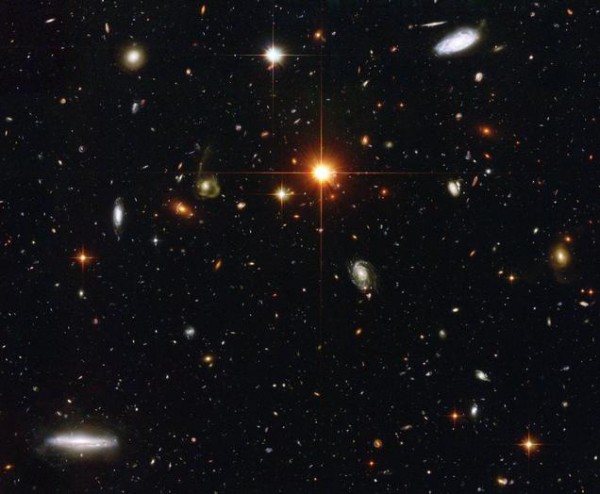
1.) The Hubble Expansion of the Universe. When we look out at distant galaxies, we find that the farther a galaxy is from us, the faster it's receding from us! It was realized pretty early on that this is because space itself is expanding!
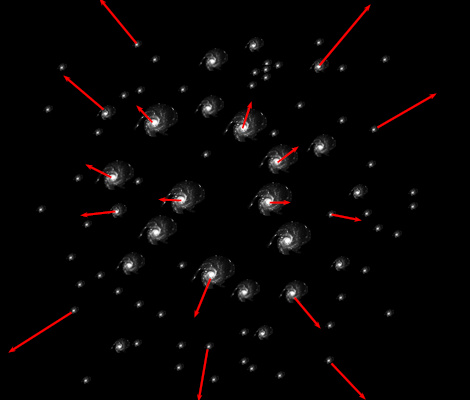
This means that the farther away a galaxy gets from us, the faster it will speed away in the future. Weird!
So logically, you reason, in the past, things were closer together!
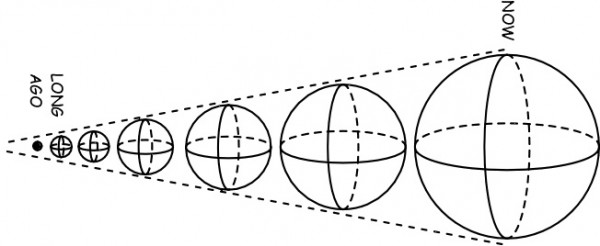
Well, what are the consequences of that? If things were denser and space was smaller, than things were hotter in the past, which means that we can look at what happens if things get hot enough.
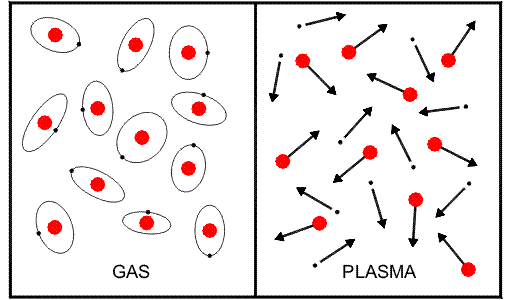
Well, if you heat normal matter, the electrons get ionized, and so there should be a "leftover glow" from when your atoms went from being an ionized plasma to being a neutral gas. And that energy should have redshifted into the infrared, or even farther, into the microwave.
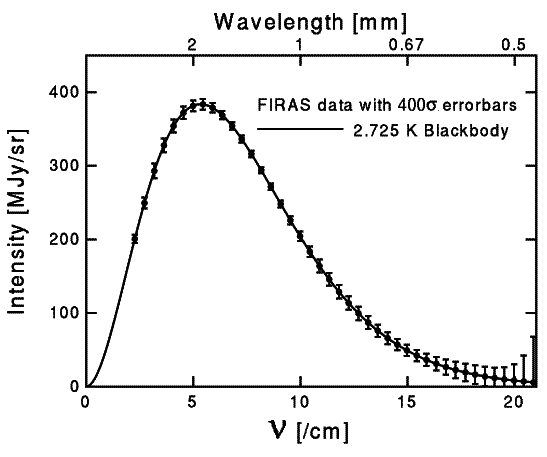
2.) That's the Cosmic Microwave Background! And its discovery in 1964 (and amazingly precise measurement, above, by COBE in the 1990s) confirmed that not only does it exist, but it's the exact temperature and spectrum as predicted by the Big Bang!
In fact, if we go back farther, what would we expect? Perhaps it was so hot and dense that the plasma could even destroy individual nuclei, so that only protons, neutrons, electrons, and radiation were left?
Well, you'd expect very precise predictions for the amount and type of nuclear fusion you get when the Universe becomes cool enough to form stable nuclei that aren't blasted apart by the radiation. So we come to #3...
3.) The abundances of the light elements due to Big-Bang nucleosynthesis.

And that's exactly what we get! So the Big Bang looks great all around!
But it's a 65-year-old idea; there are a bunch of things it doesn't say anything about. Such as...
Why is there all this structure -- stars, galaxies, clusters of galaxies and more -- if the Universe was so smooth and even at the start?
It's a good question, and one that the Big Bang, on its own, doesn't answer. What else doesn't the Big Bang do a good job of answering?
Why is the Universe spatially flat? It could, in principle, be any shape or curvature, and what we find, experimentally, is that it's really, ridiculously flat. In fact even looking at the temperature fluctuations as we measure them today...
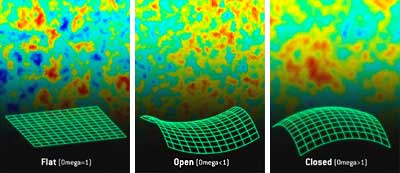
...we find that the curvature of the Universe is less than 2%, out of our observable Universe that's 93 billion light years across! That's pretty flat.
And then there's the nagging problem of temperature.
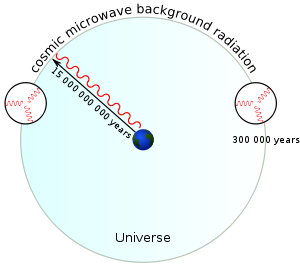
The Universe -- and in particular the Microwave Background -- is the same exact temperature in all directions in space. But why should that be? Stuff on one side of the Universe is completely disconnected, and always has been, from stuff on the other side. Yet they're the same temperature as surely as though they had always been touching one another. How's that? The Big Bang doesn't say.
And finally...
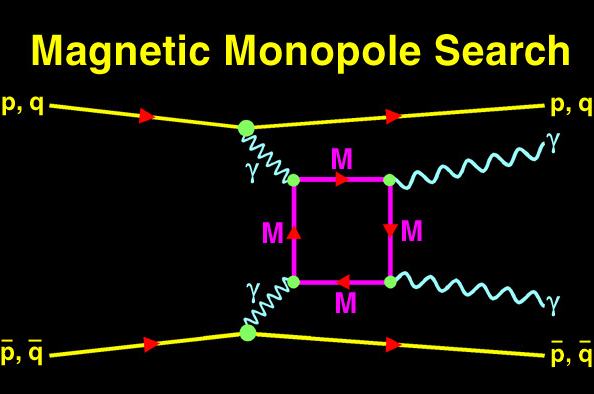
Where's all the weird stuff? If our high-energy theories are correct, the Universe shouldn't just have a microwave background and the observed abundances of the light elements, but should also have a bunch of other weird relics, like magnetic monopoles, cosmic strings, and other topological defects. Yet not a single one has ever been found.
So, Big Bang, what are we gonna do with you? Well, if you were Alan Guth, you'd find one theoretical solution to all of these problems, and it would do what any good scientific theory would do: make a new prediction, too!
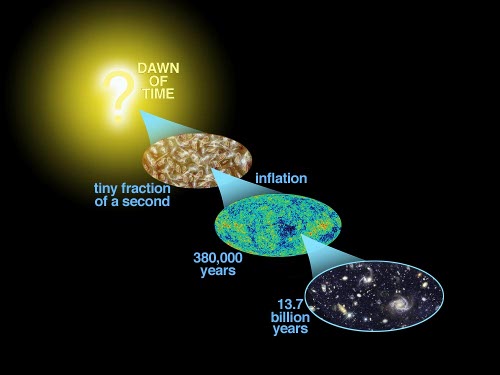
And that's what inflation is. It says that, in order to set up the Big Bang, just prior to this hot, dense, expanding state, the Universe was expanding exponentially fast, doing the following things:
- Stretching space -- whatever shape it was in before -- to be so large that it appears flat.
- Taking a teeny-tiny region that was in equilibrium -- where it all had a chance to reach the same temperature -- and stretches it across the Universe to fill our entire, observable Universe with what was once that small, uniform-temperature region.
- Taking whatever existed before -- magnetic monopoles, cosmic strings, etc. -- and inflating them away, so that at most, one of them exists in our Universe.
- And finally -- that new prediction -- quantum fluctuations that exist during inflation give a prediction for the type and spectrum of fluctuations that started off in our Universe.
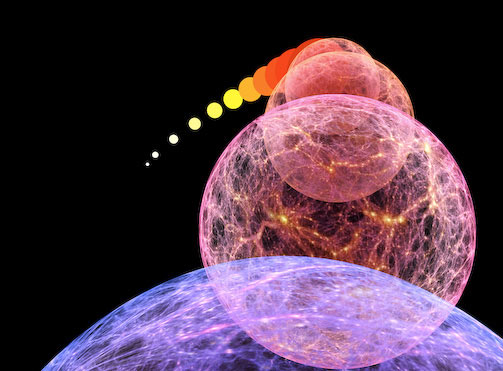
This last one is particularly important, because these fluctuations will not only be measurable in the cosmic microwave background (but weren't in 1979, when Guth first wrote about it), but also in the large-scale structure of our Universe!
So when we made these measurements of the microwave background...
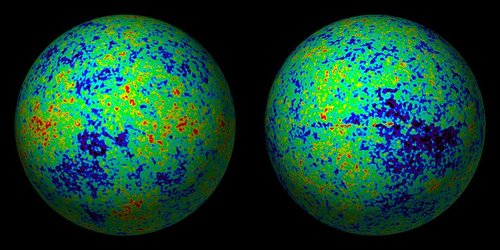
...and of large-scale structure...
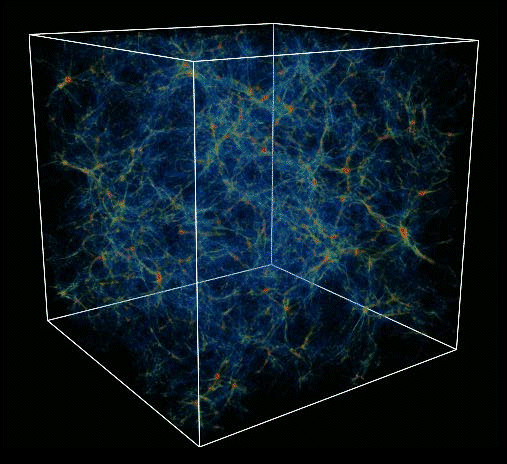
And that's why, unlike for Supersymmetry at the LHC, I think that there's about a 98% chance that inflation is correct!
This also means that every single image you see that places the Big Bang before inflation in the cosmic timeline:
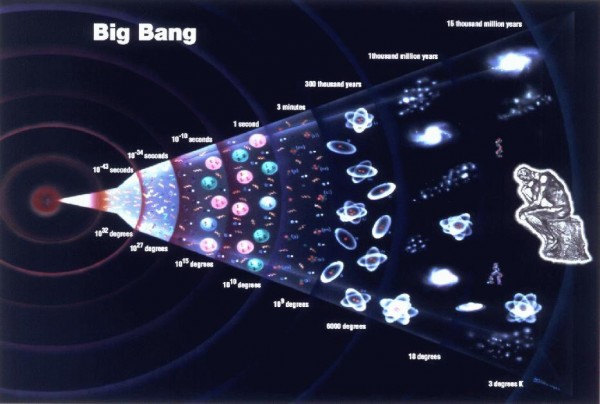
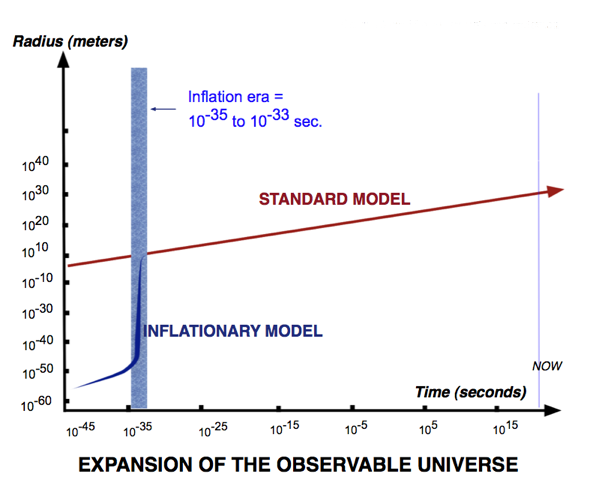
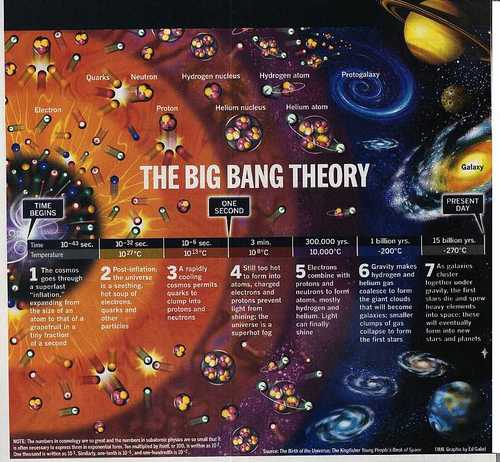
is not only wrong, but dishonest. Why? Because we have no idea what happened prior to inflation, and by the very nature of inflation, we can't. That's as far back as physics allows us to go, at least, right now.
So to recap, inflation is the thing that happens that sets up the Big Bang. Based on what we've seen, it stretches the Universe flat, makes it the same temperature in all directions, gets rid of any junk that was lying around beforehand, and creates the proper fluctuations on all scales -- small and large -- to grow into the stars, galaxies, and clusters that we have at present. If I were offering odds, I'd bet you 50-to-1 that inflation has it right. And that's all I've got for today!


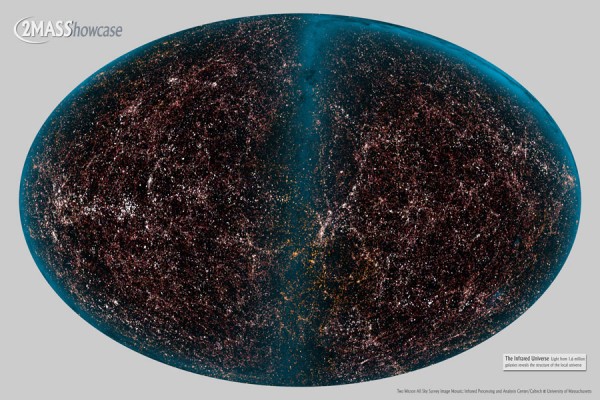
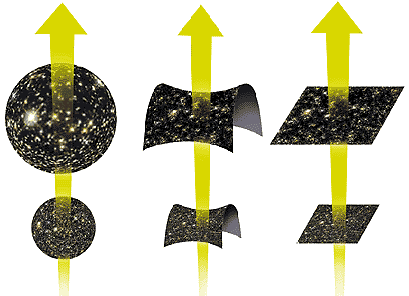
Hi Ethan. I've never been sure why people were concerned about the presence of structure and variations. Why would you expect the big bang origins to be smooth? Don't really understand the proposition that the universe is "flat" (ie in the sense that we can observe physically) - what do you mean by that? And how do those observations of temp fluctuations relate to it?
Cheers
David Horton
Hi Ethan,
Is this to say that, if inflation preceded the Big Bang, the BB was sort of a secondary (function? result? step?) of an already-inflating universe? If the universe was already inflating, the BB happened, and the universe continued to inflate, what characterizes the Big Bang as distinct from other characteristics of early inflation...that is, when did the "Big Bang" stop and "inflation" resume? (This sounds a little like the "bubble" inflationary model; what's the difference?)
Thanks!
Charity (long-time reader, first-time poster)
@David
To answer one of your questions (shape of the universe) don't think of flat as just a 2d object but as a 3d object. If you place a grid pattern in the expanding object (we will just say a cube) every line would be straight in its appropriate dimension. If we were in a curved universe the lines would have to curve so that at different points you could travel in a straight line and end up back where you started. Much like on earth if you were just to go in one direction you could circle Earth and come back to the original point, not because you changed your direction of travel but rather the space you traveled on brought you back around.
Essentialy a flat universe means that space itself operates in straight lines unless warped by gravity. I hope that helps at all!
Best,
Cody Lawson
Thank you, Ethan. Thank you.
Nice to have you once more stress that the BB is not the beginning and that indeed, we do not know what came before (which should trigger you to explain the time axis a little more).
Just one criticism: You say inflation is "exponential" as if this means that it is super fast. Not only is it actually rather slow
http://www.science20.com/alpha_meme/100_million_times_slower_light_lame…
but in fact, since dark energy has already taken over, the universe is expanding exponentially right now.
Ups, I meant to write "not know what came before inflation"
Thanks Cody, I understand the "flat" stuff mathematically (although I have always had trouble conceptually with the "open" model). Just not sure (a) why the universe wouldn't be flat (in 3 dimensions) and (b) how those temp fluctuation diagrams relate to the question.
You seem to confuse the idea of a metatheory with the idea of a theory.
From the beginning of the idea, the Big Bang theory (like Darwin's theory of evolution) has been a metatheory. In and of itself, it predicts nothing specific and gives no detail as to mechanism or process responsible for this or that observation.
Specific theories with detailed predictions (e.g. CMB or Nucleosynthesis) plug into the Big Bang metatheory; just as epigenesis plugs into Darwinian evolution. The Big Bang metatheory itself is an overarching conceptual framework that doesn't say anything in detail about anything in particular. Nevetheless the overarching framework is useful because it suggests the direction of experiment and theory necessary to fill gaps in knowledge.
Now these gaps in knowledge (i.e. observations unexplained) about which the Big Bang metatheory "doesn't say anything" will be answered in time by specific "new theory(s)", not by the Big Bang metatheory. And if a "new theory" can successfully be plugged into the Big Bang metatheory; then the Big Bang survives as a metatheory.
However, if a "new theory" with specific detailed predictions and postdictions can not successfully be plugged into the Big Bang metatheory then the Big Bang becomes less useful as an overarching framework.
Now Ethan, at the end of this blog entry you say, "inflation is the thing that happens that sets up the Big Bang."
Which is to say that the "inflation theory" fits outside the overarching framework of the Big Bang metatheory. Whereas, other specific theories (e.g. Nucleosynthesis, CMB) be fit inside the overarching framework of the Big Bang metatheory.
We can't have it both ways regarding theory and metatheory. If epigenesis didn't fit inside the overarching framework of Darwinian evolution; then the Darwinian metatheory would be seriously weakened or failed. Similarly, that inflation doesn't fit inside the overarching framework of the Big Bang metatheory weakens the Big Bang metatheory.
Of course, you can try to turn the Big Bang metatheory into a specific detailed Big Bang theory. But I don't hear you suggesting that.
Thus I predict that other observations, which are not currently explained by specific theories of the Big Bang metatheory, will (like inflation) be explained by specific "new theories" that are outside of the Big Bang metatheory.
If specific "new theories" outside of the Big Bang metatheory are needed to explain astronomic and cosmological observations; then the Big Bang metatheory will be much less useful and perhaps fail as an overarching framework.
That is my prediction. The Big Bang metatheory will fall into disuse as scientist focus on specific "new theories" necessary to explain observations (i.e. that are currently unexplained); when those "new theories" domains of relevance are shown to be outside the domain of Big Bang metatheory, in the sense that inflation is outside of the Big Bang metatheory (i.e. "inflation is the thing that happens that sets up the Big Bang".
The "superorganism" is an example of a metatheory that gained prominence and then just as quickly fell into disuse; because detailed scientific work was no longer guided by the superorganism metatheory. (e.g. a superorganism being an ant colony)
Now Ethan as to your confusion. You seem to think that "new theories" (e.g. inflation) can proliferate outside the Big Bang metatheory; and that somehow the Big Bang metatheory will still be relevant and useful. That can not happen unless the Big Bang is reduced to a specific theory (e.g. like nucleosynthesis, or epigenesis) with can be plugged into another suitable metatheory.
I'm curious -- why does inflation limit the number of "weird relics" to at most one?
So in our "3d Flat" universe, if a person can hypothetically travel to the edge of the universe, edge in the sense of whatever is at the outer border of the inflationary expansion where space is presumably stretching or being created, and flat in the sense that if it is for example a H = 2 inch by W = 1 million inch by D = 1 million inch, can we get to the edge of space faster by going to the edge of H = 2 inch?
@Cyan,
My understanding is this: It limits the number of relics in the 'observable universe'. The assumption is that the observable universe is just a tiny fraction of the actual universe. So when the entire universe underwent inflation, the amount of wierd stuff per unit volume decreased dramatically. Now we can only observe a tiny part of this universe, so we would not expect these weird things to be very common.
Great post!
I don't understand the last bit though, where you say that the Big Bang came after inflation. I've always understood the Big Bang to mean the start of our Universe, including the start of time. How do you have inflation without time?
Best regards,
Jens
âwhy does inflation limit the number of "weird relics" to at most one?â
Rather than zero?
Professional etiquette:
http://en.wikipedia.org/wiki/Blas_Cabrera
;-)
A question:
if you stretch the universe by inflation- what happens to the size of an electron, the mass of an electron or the charge?
Do they stay the same?
What do you think of doing a piece on the difference between a monopole and an electron or proton or other known particles?
Another great article with great graphics. But like some of your other great articles I disagree with your opinions of the odds. I agree the BB model might explain the microwave background, and might be able to explain the relative proportions of light elements, but the expansion of the universe is only an interpretation of the meaning of galactic redshifts based upon the BB model, it is not a fact like the mico-wave background, although few doubt it. Even Hoyle's original model also included an expanding universe.
Similarly dark matter and dark energy are not fact.
The Inflation model, I think, also has its own problems. To start with the accelerated expansion of the universe (Inflation), then its deceleration, and now acceleration again does not fit well with simplicity and Occam's Razor. Inflation also has no explanation as to its source, if not a BB event. Of course I believe none of it is valid.
Opinions and theories aside, this article is a great description of the present mainstream understandings in cosmology and the supporting evidence along with great graphics. Good work!
Another great article with great graphics. But like some of your other great articles I disagree with your opinions of the odds. I agree the BB model might explain the microwave background, and might be able to explain the relative proportions of light elements, but the expansion of the universe is only an interpretation of the meaning of galactic redshifts based upon the BB model, it is not a fact like the mico-wave background, although few doubt it. Even Hoyle's original model also included an expanding universe.
Similarly dark matter and dark energy are not fact.
The Inflation model, I think, also has its own problems. To start with the accelerated expansion of the universe (Inflation), then its deceleration, and now acceleration again does not fit well with simplicity and Occam's Razor. Inflation also has no explanation as to its source, if not a BB event. Of course I believe none of it is valid.
Opinions and theories aside, this article is a great description of the present mainstream understandings in cosmology and the supporting evidence along with great graphics. Good work!
Sorry for the double posting above. I think it was a problem with my computer.
Opinions and theories aside, this article is a great description of the present mainstream understandings in cosmology and the supporting evidence along with great graphics. Good work!
Well good thing modern medicine doesn't embrace this type of guesswork. Hell I would have been dead along time ago. I prefer to think that space aliens created the universe with a series of productive sneezes and we are just not to the point of ultimate realization yet. How unfortunate it is that science has been hijacked by such loose guesswork.
So inflation is the like the cosmic version of shaking the Etch-A-Sketch before the Big Bang started turning the knobs?
The lead article, current issue of Scientific American: The Inflation Debate: Is the theory at the heart of modern cosmology deeply flawed? By Paul J. Steinhardt
"in the 30 years since Guth introduced it. As the case for inflation has grown stronger, so has the case against it."
"When all factors are taken into account, the universe is more likely to have achieved its current condition without inflation than with it."
"A flat universe without inflation is much more likely than with inflation--by a factor of 10 to the google (10^100) power!"
"the predictions of the early 1980s were based on a naive understanding of how inflation actually works--a picture that has turned out to be dead wrong."
"And if the theory does not make testable predictions, how can cosmologist claim that the theory agrees with observations, as they routinely do?"
"many leading theorist argue that the problems with inflation are mere teething pains."
Others (including Steinhardt) "contend that the problems cut to the core of the theory, and it needs a major fix or must be replaced."
"detecting a gravitational-wave imprint would support inflation; failure to detect it would be a major setback."
OKThen quoted: "A flat universe without inflation is much more likely than with inflation--by a factor of 10 to the google (10^100) power!"
I hope that Sci Am got the name of 10^100 correctly: it is a googol, not a google. And 10^googol also has a name; it is a googolplex. But I would not be too surprised if they got it wrong. They have been wrong, on more than mere spelling, quite often.
I don't know what the context of this Steinhardt probability "calculation" is, but it is assuredly pure bullshit. That kind of "probability" is not accessible by any kind of rational process.
Posted by: Tütüne Son | March 19, 2011 6:42 PM
20
Well good thing modern medicine doesn't embrace this type of guesswork. Hell I would have been dead along time ago. I prefer to think that space aliens created the universe with a series of productive sneezes and we are just not to the point of ultimate realization yet. How unfortunate it is that science has been hijacked by such loose guesswork.
I would also agree that having Ethan explain his "time axis" a little more would be great. I was also a bit confused as to what he meant by inflation setting up the big bang, but to his credit, it was only one or two short paragraphs.
Thanks, Ethan, for your posts, I love them!
And by my previous post, I mean something like
"Whatever the universe was like before (monopoles, etc), it was expanding at some crazy rate. Then, our "big bang" happened - that looks like this. Now this is how BB and inflation relate to each other, this is the mainstream ideas, and these are why I disagree. Also, have some pictures."
Yeah, that's why I read blogs, not write them. But a more in depth explanation of that whole idea would be good, I think, as after reading the comments it seemed like I wasn't the only one a bit confused by what Ethan wrote
"Well good thing modern medicine doesn't embrace this type of guesswork. Hell I would have been dead along time ago. I prefer to think that space aliens created the universe with a series of productive sneezes and we are just not to the point of ultimate realization yet. How unfortunate it is that science has been hijacked by such loose guesswork."
Right -
Calculations made from the mathematical and physical modelling of the expanding universe theory predicted the temperature of the Cosmic Background Radiation to be about 3K
WMAP measured it and found it to be 2.725° K
Guesswork??? My doctor should be as accurate tw@
Another great post in the series. What were the odds? :-D
+1 on the criticism of BB before inflation. If I would question anything in the post, it would the reverse when it claims that we can't have predictions from pre-inflation physics.
If we can pare down inflation models, it may well be that such models as eternal inflation comes out as victors. In that case we could find that there wasn't anything "pre-inflation", which is the equivalent knowledge.
Many questions left hanging. FWIW:
@ Charity, Jens:
Siegel describes how for physicists "Big Bang" is mainly the over all expansion of the universe, not specifically the initial process.
Inflation has a semiclassical approximation of spacetime "time", aka "worldlines". As a process, of course it has time no matter what anyway.
@ OKThen:
If we get behind nonsense philosophy which "In and of itself, it predicts nothing specific and gives no detail", BB theory is predictive without further constraints. Much as processes such as gravitation and evolution are by merely existing.
BB at large tells of Hubble expansion, cosmological redshift, the brightness of the sky (i.e. why it isn't bright and hot like star surfaces overlapping in all directions) et cetera. Gravitation at large tells of unidirectional so mono-charged, long range so 1/r^2 interaction. Evolution at large tells of nested hierarchies, interlocking complexity and layered fossils.
Nitpick: A metatheory would be a theory about theories, such as Popper's falsification theory (which is itself falsifiable, as it must if it goes meta). Theories incorporating theories are just that.
@ forrest noble: You make many wrong claims, but to pick some, DE and DE are observable facts. It is funnily inflation, which doesn't stand by itself in test as of yet but only within LCDM cosmology.
time doesnt exist who is to say how much time passes. its just a bunch of numbers that we created and agree upon to be logical
http://rodeneugen.wordpress.com/2013/12/25/pretentious-chat-of-neophyte…
Since the observations show us that the Universe expansion is accelerating, logically should be expected that this acceleration existed from the beginning of the time, (when the so called Big Bang occurred). This theory solves the problem of need for inflation, which is not coherent with the existing paradigms of the science, like speed of light etc. Yet it raises new problems, like how to explain the flatness, homogeneity, and isotropy of the Universe.
I want to send a link to where i propose an alternative theory called the big spin viz;
https://rodeneugen.wordpress.com/2013/07/02/pretentious-chat-about-phys…
I am fully aware of me being very far from understanding the field and the Mathematics of it, and don’t want to be pretentious to understand to much about the subject. Yet i take the courage to suggest out of my ignorance an extra universe explanation to the very existence of all.
My theory says, “Since everything in the Universe is in movement, and the movement is the basic bloc to the very existence, why the universe itself shouldn’t be in movement?”.
In the link above i still suggested that the Big Bang should be called a Big Spin, while suggested all started with a Big Multi-axis spin of the universe.
You answer to my ideas was as follows;
Your model would fit a linear “Hubble” expansion law. Unfortunately, as I said, the usual BB model has an enormous inflation, to start with, and now apparently we observe an accelerating inflation.
Another problem is that in a rotation appears a so called “Coriolis force”. On Earth, it causes “Trade Winds”. In space, it would cause something similar, on a larger scale, a systematic Coriolis deviation. an anisotropy of the universe. To my knowledge that has not been observed (although some other features seem present, of unknown origin). it would in particular affect cosmological photons (redder in one direction than in another).
Still another problem would be that the tremendous acceleration necessary initially would prevent the gathering of matter long present, and observed, as gravity would be nothing relative to that acceleration.The usual Big Bang is in part here to convince the public that the “Standard Model” is of some use (that’s my cynical view of it). Although, personally, I think it’s interesting by itself. It’s true it provides a neat explanation of the 3K cosmological background radiation…
——————————————————–
After thinking again as an amateur, i thought, why to stick only to circular movement, there are after all many other forms of movement we know, just to mention some, expansion and contraction, vibration,linear straight movement, etc. All of them could be created/happened at the moment of the very beginning. And if to relate the theory to your model of “100 Billion Year Universe”, if the Universe started its expansion gradually, why couldn’t be that the movement like spin, vibration, etc. started gradually too, and its acceleration continuous to this days?
Yet i understand every mathematical model has to have some anchor presupposition. I would start with the speed of light, unless even in this phenomena were found some irregularities, which i don’t know about.
If to continue with the idea, Mathematically i would try to see what kind of movements of a Planck scale dot are necessary to explain the expansion of the universe from one point to the today vastness, and explain all the unexplained phenomenons that oppose the existing paradigms of the science.
As a supplementary of my naive theory of everything i would assume that the very creation happened, when certain type of movement (spin, vibration, etc.) caused the split of the nothingness at Planck scale to matter and antimatter, while certain kind of asymmetric movement made the matter more abundant then the antimatter.
Everyone seems to be caught up in the fire cracker theory of cause and effect, However the math only works with models as it relates to infinity. Which in my opinion infinity can only be used to define as a concept that can not be used in equation because by its very nature and concept changes to one more one more and one more add infinitum. An alternative is that expansion is both all inclusive and ongoing. From a singularity. That's why we can not observe it until you reach great distances, it is a matter of relative nature and also explains alot of other things that with existing math computing with respect to infinite will never be anything but an approximation if you will, ever changing but not definable in the present. We can not know the future so we look back in order to predict it. While this may give an explanation it's only approximate. In the beginning inflation started as a creation of God not man.Singularity. It has its own value according to its creator. Mans defining is merely folly when we move outside of the boundary of the finite. If you really want to blow your mind imagine that light "c" ever expanding with space and time is only relative not constant because it is only observable in the present. They say that things appear smaller the farther you away from something you observe because of angular narrowing however if that is the case then why does a red shift appear ? Would it not be more logical to assume that light is also accelerating to conform to the increase with space. From what we know of expansion the math model of theories don't fit we would long ago have lost the ability to observe back more than an instant unless c increases with the inflation of space in time. Ever expanding but not observable because we along with everything else we are expanding right along with space through time looking back at what was, only able guess what will be. My theory of everything.
Ethan,
You wrote that inflation is
"Taking a teeny-tiny region that was in equilibrium — where it all had a chance to reach the same temperature — and stretches it across the Universe to fill our entire, observable Universe with what was once that small, uniform-temperature region.,"
But the illustration (expansion diagram) appears to say otherwise (and it is missing a tick-mark for 1E-20):
after one "Planck time," the "radius" of what will become the Universe is one "Planck length" (1.62E-35 m), but the "graph" indicates that the radius is ~ 1E-55 m, that's 20 orders of magnitude (!) too small (anything less than one Planck length lies outside physics).
The "graph" also appears to indicate that as inflation ended, the Universe radius was ~ 1 m (10E0), how does that "fill our entire, observable Universe"?
Obviously, the graph is bogus (where did you get it?). Could you please provide the numbers for inflation start, inflation end, and expansion factor? The numbers Guth used originally was 1e-35 s, 1e-33 s, and 1E25, respectively (which would make the Universe, at 1e-33 s, the "size of a grapefruit" (Guth's own words), hardly the entire observable Universe.
What are the numbers cosmologists today rely upon?
Many thanks in advance!